Jason Ledoux
Starting in the 1880s Art Nouveau was an experimental, ornamental art style that gained traction within western Europe. Though it gained international notoriety, the movement only lasted for around 30 years to 1910 when it began to lose popularity. The movement itself was motivated by the idea that artists wanted to move away from creating art using eclecticism, which is the concept of drawing from other sources to create a greater whole. In other words Art Nouveau was an attempt to break away from the constrictions of traditional art styles at the time, hence why the name literally means “new art” in French. The movement actually had no central name at the time of its relevancy, but rather many countries had their own name for it. The style was called Jugendstil in Germany, Sezessionstil in Austria, Stile Floreale (or Stile Liberty) in Italy, and Modernismo (or Modernista) in Spain.
The two most defining features of Art Nouveau include heavy inclusion of imagery from nature, and the use of what is known as the whiplash line. These lines are characterized by their smooth, flowing, and chaotic nature. They must be created in swift and decisive movements so that the line appears natural. The use of vines, branches, water, and even hair worked well with the whiplash line. It takes inspiration from how calligraphy, especially in countries like Japan, is done. In fact what is considered the precursor to the Art Nouveau was the inclusion of Japanese prints in interior decoration by decorator Edward William Godwin in 1862. He was a well known house decorator born in 1833 and died 1886. Much of the movement of Japanese inspired art in Europe happened back in the 1860s when trade opened up with Japan. Both the natural designs and use of the whiplash line were inspired by Oriental(Asian) art that had been growing in popularity at the time.
The most well known Art Nouveau patrons all had their own collection and fascination with the foreign art styles. These three men are considered leaders of the movement. An English merchant Arthur Lasenby Liberty who was born 1843 and died in 1917 was inspired by Godwin’s designs, which lead him to creating his textile company Liberty & Company that contributed to the Art Nouveau movement. M. Samuel Bing a German art dealer from Hamburg who was born in 1838 and died in 1905 and had made a name for himself as an oriental art deal created an art shop in Paris for young artists called L’Art Nouveau to explore their new experimental styles. Louis Comfort Tiffany an American business owner born 1848 and dead 1933 used his resources to create a glass work manufacturing company that lead to Art Nouveau pieces becoming much more easily available to the public in the United States.
With the help of these men and more Art Nouveau became a style of art primarily used for design and decoration. It came in forms of paintings, prints, jewelry, ceramics, architecture, furnishings, and interior design. Ceramics stands out the most as it was mass produced by companies like Tiffany’s, and there is very clear contrast between standard European style pottery and that of Art Nouveau. Overall the Art Nouveau is a reflection of the rise in popularity of Japanese and other oriental arts, and how that popularity influenced European art afterward.
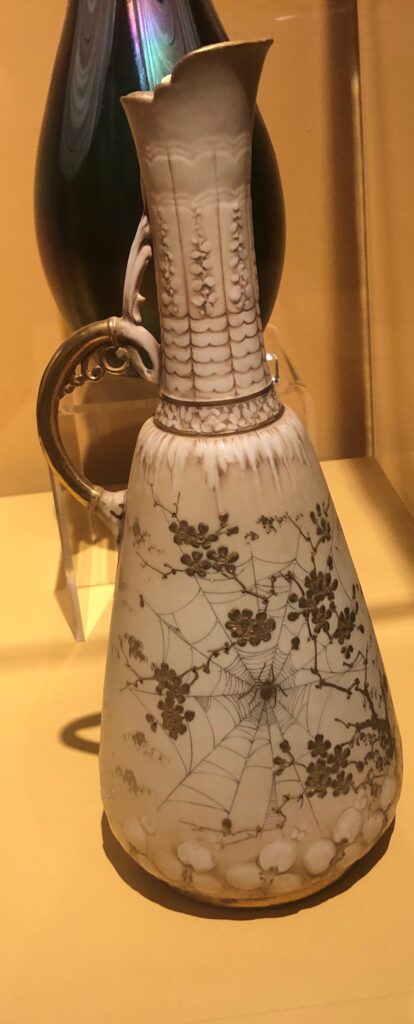
Title: Spider Web Vase
Date: 1892-1905
Creator: Riessner, Stellmacher
Medium: Czech Republic Porcelain
Repository: Lyman Allyn Art Museum
Accession Number: 1963.45
Photo by Jason Ledoux
Description: This piece is a decorative vase made in one of the many porcelain manufacturers that sought to be part of the Art Nouveau movement. The shape is a cylinder that starts out normal and gradually thins until the top is a thin tube with slight curves for pouring. Around the tube is a repeating pattern of straight vines with a flower on top. On the main body of the vase is a depiction of a spider web with a large spider in the center and the branch of a cherry blossom growing around it. The background and style used for the vase is heavily inspired by how similar imagery is depicted in actual Japanese art. This can be recognized most easily with the color of the background that is similar to many Japanese paintings and prints, and the style of how the branches and flowers of the cherry blossom are done. Note also how the branches make use of the whiplash line.

Maker: Auguste Delaherche (French, Beauvais 1857–1940 Paris)
Date: ca. 1889
Culture: French, Paris
Medium: Stoneware
Dimensions: Overall (confirmed): 17 3/16 × 8 5/8 × 8 5/8 in., 12.6 lb. (43.7 × 21.9 × 21.9 cm, 5.7 kg)
Classification: Ceramics-Pottery
Credit Line: Robert A. Ellison Jr. Collection, Purchase, Acquisitions Fund; Louis V. Bell, Harris Brisbane Dick, Fletcher, and Rogers Funds and Joseph Pulitzer Bequest; and 2011 Benefit Fund, 2013
Accession Number: 2013.483
Description: This vase has a standard shape as a cylinder that gradually widens, but the quickly shrinks near the top. The majority of the vase makes use of clear white as a background and a dark blue for some details and highlights. Both of which are common colors used in Japanese art. Surrounding the base is a repeating pattern of dark blue circles that bear a similarity to lotus petals with an inner design of two whiplash lines widening and coming together at the inner top. In between the circles emerge individual peacock feathers that alternate between half the height of the vase and three quarters the height.
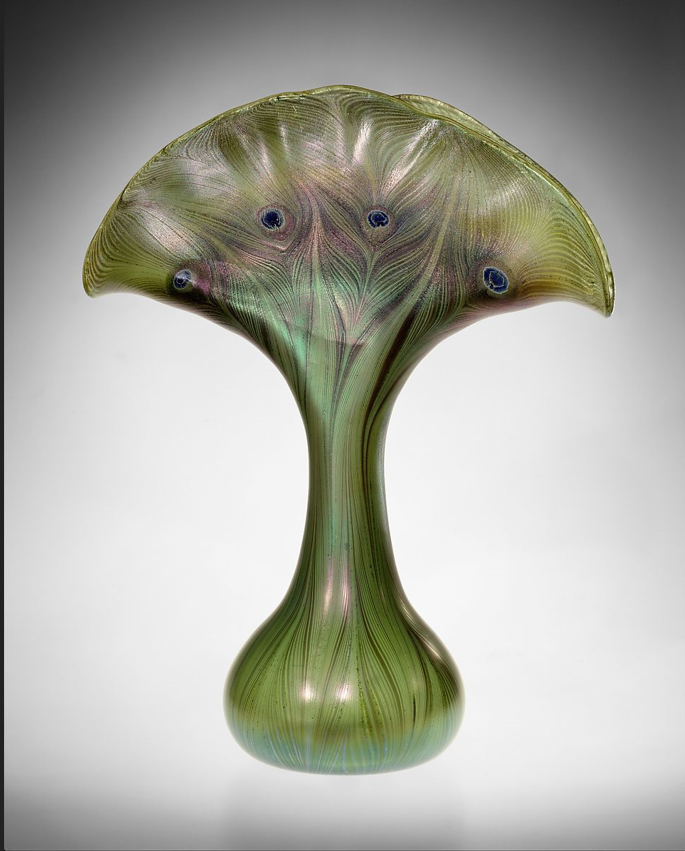
Title: Vase
Designer: Designed by Louis Comfort Tiffany (American, New York 1848–1933 New York)
Maker: Tiffany Glass and Decorating Company (American, 1892–1902)
Date: 1893–96
Geography: Made in Queens, New York, New York, United States
Culture: American
Medium: Favrile glass
Dimensions: 14 1/8 x 11 1/2 in. (35.9 x 29.2 cm)
Credit Line: Gift of H. O. Havemeyer, 1896, The Metropolitan Museum of Art
Accession Number: 96.17.10
Description: This vase is one of many created by the Tiffany Glass manufacturer. The shape of the vase itself stands out as different from that of a standard vase. The base is small and spherical, which then moves up to thinner center neck that compared to the rest of the vase has the appearance of a stem. Moving up the opening both flattens and spreads to create a flat, semicircular top. The vase is covered in thin, flowing green whiplash lines with blue dots towards the top, and this creates imagery of peacock feathers. The shape of the opening and colors of the vase work together to evoke the imagery of a peacock displaying it feathers in full. The excessive use of green and blooming opening may also evoke flower imagery as well.
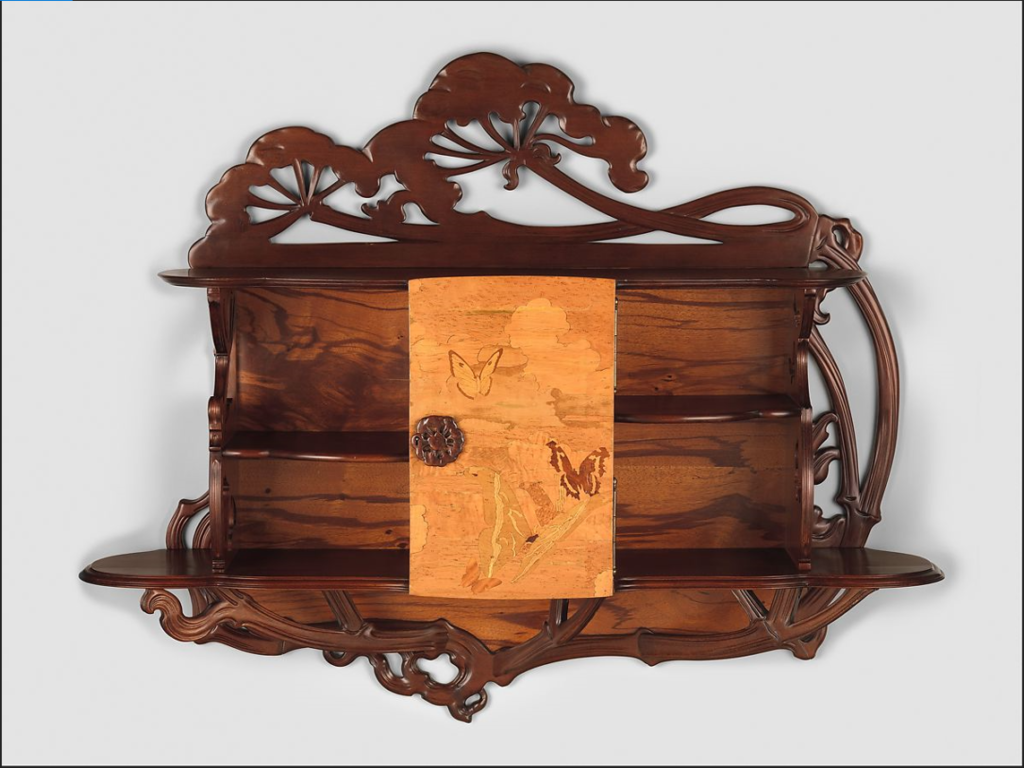
Artist: Emile Gallé (French, Nancy 1846–1904 Nancy)
Manufacturer: Établissements Gallé
Date: ca. 1900
Medium: Birchwood, rosewood, various other woods
Dimensions: 40 x 49 1/2 x 12 in. (101.6 x 125.7 x 30.5 cm)
37 lb. (16.3 kg )
Classification: Furniture
Credit Line: Anonymous Gift, 1982, The Metropolitan Museum of Art
Accession Number: 1982.246
Description: This piece of furniture is a two level shelf designed to be hung on a wall. The wood is a nice brown with polish to make it shine. The bottom shelf extends out of the boundaries of the shelf to create more space for items. Along the edge of the shelf is a continuous tree branch that moves from the bottom, to the right, and ends at the top of the shelf. This branch makes use of the whiplash line technique to look as if it grows naturally out of and around the shelf. Built into the center of the shelf is a small cabinet that is made of lighter color wood. The small door of the cabinet has been delicately carved into an image of several butterflies flying through the sky. The design and style used on the door is reminiscent of the two dimensional style used for Japanese prints.
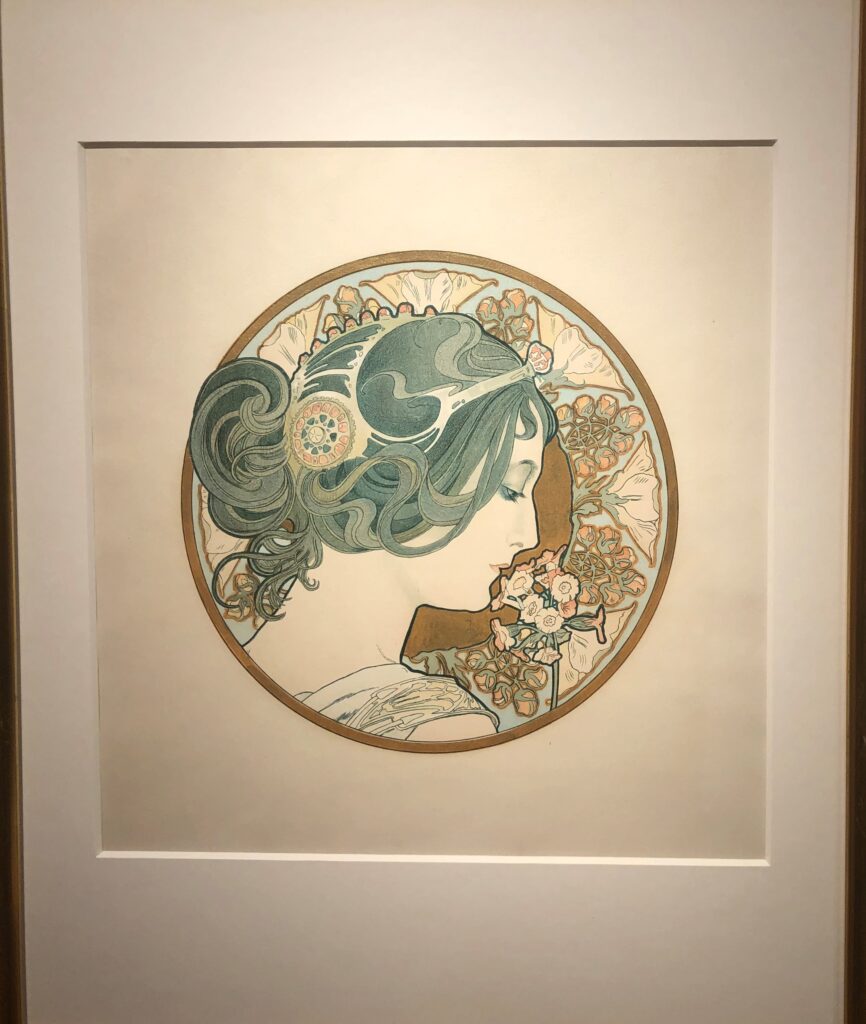
Date: 1899
Creator: Alfonse Maria Mucha (Czech 1860-1939)
Medium: Lithograph on paper
Culture: Czech/French
Repository: Lyman Allyn Art Museum
Accession Number: 1964.252
Photo by Jason Ledoux
Description: This painting is side profile of beautiful, fictional woman with a sprig of flowers held closely to her face as if she is smelling them. The choice of using a side view comes from the painters experience in painting and drawing many women for posters and advertisements. The artist Alfonse Mucha also took much inspiration for his designs from Japanese prints. The woman’s hair is a greenish blue that is loosely tied together in a bun using an intricate jewelry headpiece to help keep its shape. Use of the whiplash line can be seen in multiple parts of the long, flowing design of the hair. In the background circling the woman is an alternating pattern of blooming and budding flowers.

Creator: Ivan Bilibin
Date: 1906
Culture: Russian
Medium: Print
Description: This print is a depiction from a scene within a Russian fairy tale. To the right is a king dressed in flowery robes with spear bearing soldiers behind him. He is pointing to what appears to be a queen emerging from a tent to the left. Between the king and queen are several dead bodies lying on the ground with various weapons protruding from them. This print portrays as scene within the fairy tale where the Tsar Dodon has gone to battle against a hostile nation, and has become awestruck by the beauty of their Tsaritsa Shemakha. The influence of Japanese prints on the artist can be seen within this print. The use of colors is reminiscent of those used in Japanese prints, especially in the different fabrics within the print. The robes of the king both make use of Japanese style flower patterns, and also resembles the design of Japanese kimonos.
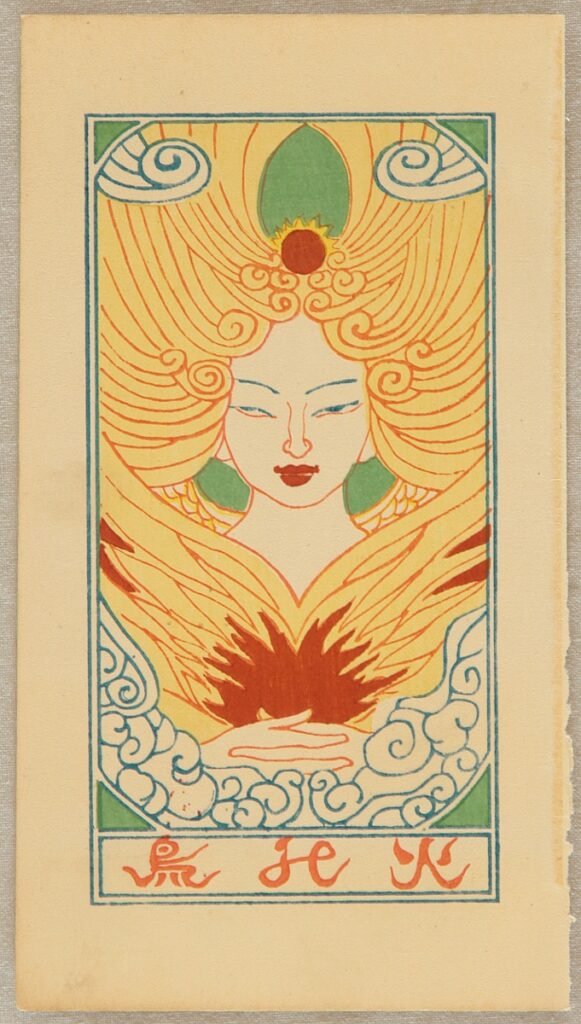
Creator: Hiromitsu Nakazawa (1874-1964)
Medium: Woodblock Print
Culture: Japanese
Repository: None (Auctioned)
Description: A wood block print portrait of a beautiful, pale woman. The features of her face are of Japanese style with the use of bold blues and reds to highlight her beauty. She wears a dress shown down to her mid-chest area that uses red, yellow, and outlines of orange in a pattern that gives the visage of flaming wings. Actual wings can be seen behind the woman. The her hair uses the same yellow and orange outline without the red. It is spread out and up in a more flowing style that makes use of the whiplash line which moves in the same direction as the dress. On top of her head is a red circle that looks like the sun, and clouds are in the corners and bottom of the print. All these features combined give the impression that the woman is meant to represent a phoenix flying through the sky. The artist’s inspiration came from a Russian ballet called “L’oiseau de Feu” (Fire Bird). The portrait may represent what the dancer would look like in the performance, or how she is described as in the ballet script.
Image Sources
Emile Gallét Ombellifères” (cow parsley) Cabinet, 1900, Birchwood, The Metropolitan Museum of Art, New York. https://www.metmuseum.org/art/collection/search/482526
Louis Tiffany, Vase, 1893-96, Favrile Glass, The Metropolitan Museum of Art, New York. https://www.metmuseum.org/art/collection/search/9480
Auguste Delaherche, Vase with peacock feathers, 1889, Ceramics-Pottery, The Metropolitan Museum of Art, New York. https://www.metmuseum.org/art/collection/search/239367
Ivan Bilibin, The Tale of the Golden Cockerel, 1907, Colored Print, No known physical copy. https://en.opisanie-kartin.com/illustration-to-the-tal
Text Sources
Gontar, Cybele. “Art Nouveau.” Metmuseum.org, 2006, https://www.metmuseum.org/toah/hd/artn/hd_artn.htm.
Lancaster, Clay. “Oriental Contributions to Art Nouveau.” The Art Bulletin, vol. 34, no. 4, 1952, p. 297., https://doi.org/10.2307/3047441.
Zelazko, Alicja. “Art Nouveau.” Encyclopædia Britannica, Encyclopædia Britannica, Inc., https://www.britannica.com/art/Art-Nouveau.